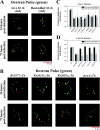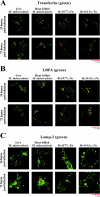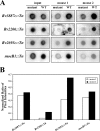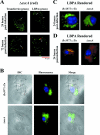A genetic screen for Mycobacterium tuberculosis mutants defective for phagosome maturation arrest identifies components of the ESX-1 secretion system
- PMID: 17353284
- PMCID: PMC1932882
- DOI: 10.1128/IAI.01872-06
A genetic screen for Mycobacterium tuberculosis mutants defective for phagosome maturation arrest identifies components of the ESX-1 secretion system
Abstract
After phagocytosis, the intracellular pathogen Mycobacterium tuberculosis arrests the progression of the nascent phagosome into a phagolysosome, allowing for replication in a compartment that resembles early endosomes. To better understand the molecular mechanisms that govern phagosome maturation arrest, we performed a visual screen on a set of M. tuberculosis mutants specifically attenuated for growth in mice to identify strains that failed to arrest phagosome maturation and trafficked to late phagosomal compartments. We identified 10 such mutants that could be partitioned into two classes based on the kinetics of trafficking. Importantly, four of these mutants harbor mutations in genes that encode components of the ESX-1 secretion system, a pathway critical for M. tuberculosis virulence. Although ESX-1 is required, the known ESX-1 secreted proteins are dispensable for phagosome maturation arrest, suggesting that a novel effector required for phagosome maturation arrest is secreted by ESX-1. Other mutants identified in this screen had mutations in genes involved in lipid synthesis and secretion and in molybdopterin biosynthesis, as well as in genes with unknown functions. Most of these trafficking mutants exhibited a corresponding growth defect during macrophage infection, but two mutants grew like wild-type M. tuberculosis during macrophage infection. Our results support the emerging consensus that multiple factors from M. tuberculosis, including the ESX-1 secretion system, are involved in modulating trafficking within the host.
Figures






References
-
- Behr, M. A., M. A. Wilson, W. P. Gill, H. Salamon, G. K. Schoolnik, S. Rane, and P. M. Small. 1999. Comparative genomics of BCG vaccines by whole-genome DNA microarray. Science 284:1520-1523. - PubMed
-
- Berthet, F. X., P. B. Rasmussen, I. Rosenkrands, P. Andersen, and B. Gicquel. 1998. A Mycobacterium tuberculosis operon encoding ESAT-6 and a novel low-molecular-mass culture filtrate protein (CFP-10). Microbiology 144(Pt. 11):3195-3203. - PubMed
-
- Chua, J., I. Vergne, S. Master, and V. Deretic. 2004. A tale of two lipids: Mycobacterium tuberculosis phagosome maturation arrest. Curr. Opin. Microbiol. 7:71-77. - PubMed
Publication types
MeSH terms
Substances
Grants and funding
LinkOut - more resources
Full Text Sources
Other Literature Sources
Molecular Biology Databases

